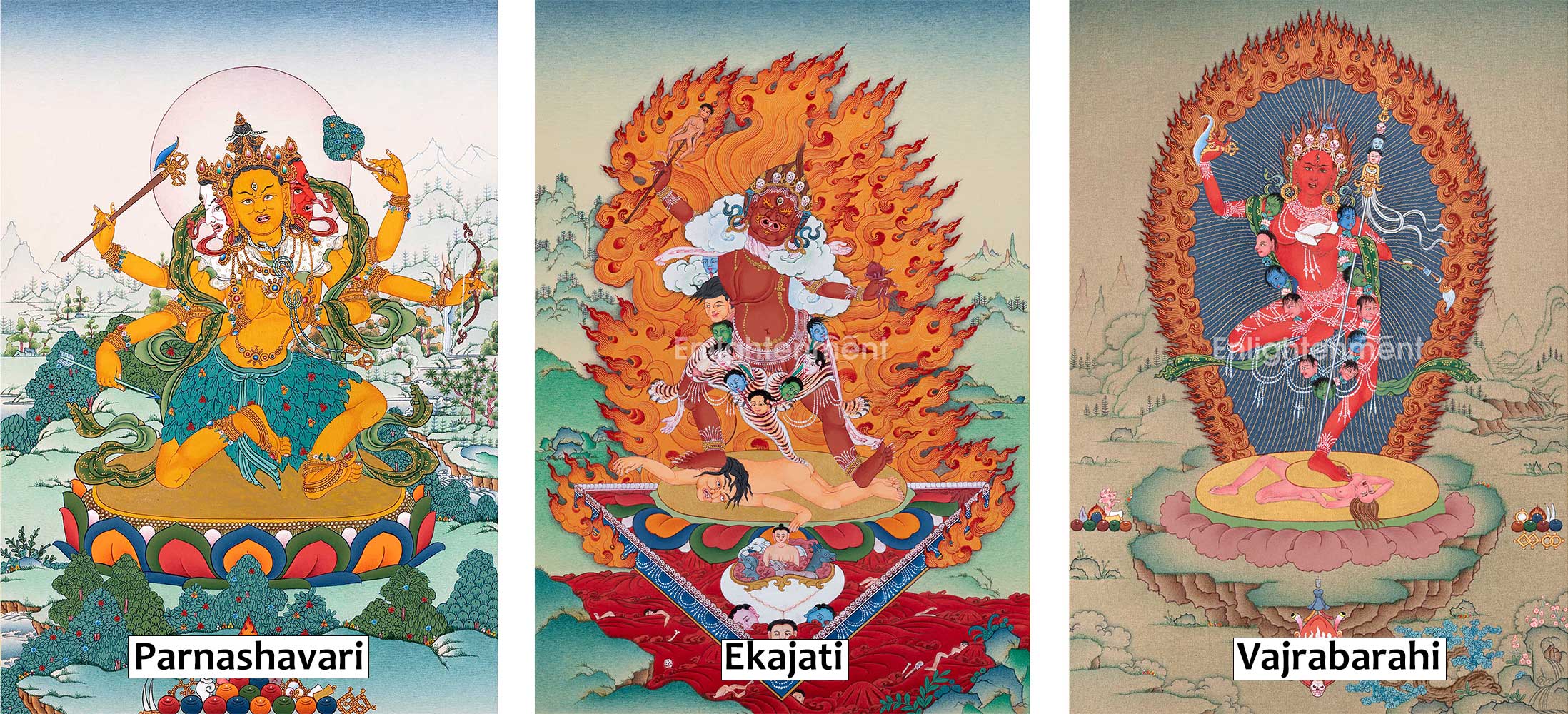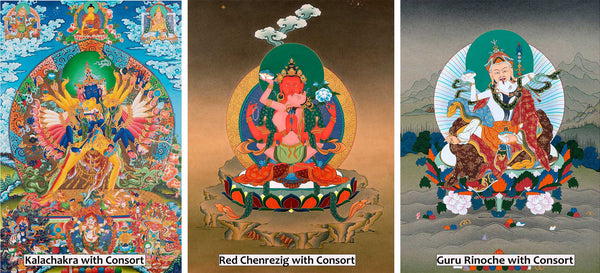Empowering Icons: The Role of Female Deities in Buddhist Tradition
Buddhism is a religion and philosophy practiced throughout many countries and civilizations. It has a diverse array of divine characters and many major female deities.
These characters reflect different facets of knowledge, compassion, and strength; they vary from aggressive defenders to gentle saviors. This article explores the roles, symbolism, and worship of female deities in Buddhism, highlighting their diversity and relevance throughout many traditions.
Key Takeaways
- Female deities in Buddhism are revered across various traditions for their compassion, wisdom, and protective powers.
- They are often associated with Mother Earth, fertility, wisdom, and spiritual liberation.
- Popular deities include Tara, Prajnaparamita, and Kuan Yin, embodying unique attributes and roles.
- Worship practices vary significantly, highlighting the cultural diversity within Buddhism.
Roles and Significance
- Compassion & Protection
Buddhism's female goddesses frequently represent the protective and compassionate qualities of mothers. They are viewed as protectors and nurturers who provide their followers with physical and spiritual safety. The characters Tara and Kuan Yin, admired for their boundless kindness toward sentient beings, are the most notable examples of this.
- Wisdom & Enlightenment
Feminine goddesses are frequently linked to wisdom and the road to enlightenment, as well as compassion. For example, Prajnaparamita is personified as the "Great Mother" of all Buddhas, symbolizing the ultimate knowledge beyond ordinary comprehension.
Prominent Female Deities
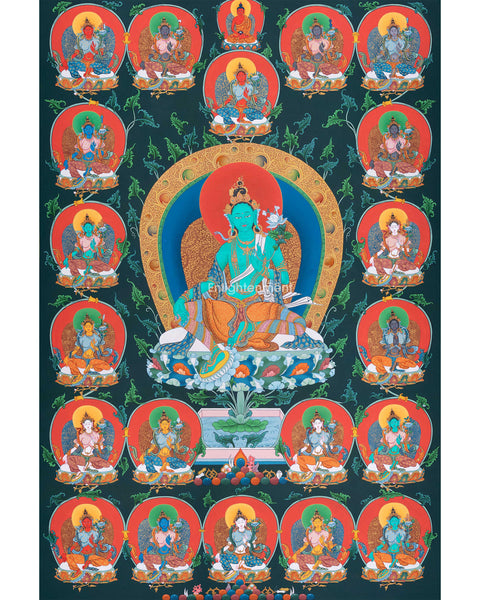
|
Category |
Role |
Examples |
Primary Function |
|
Wisdom Deities |
Embody the perfection of wisdom |
Prajnaparamita, Saraswati, Manjushri (female aspect) |
Teaching and enlightenment |
|
Compassion Deities |
Represent boundless compassion |
Tara (Green Tara, White Tara), Kuan Yin, Avalokiteshvara (female aspect) |
Protection, healing, assistance |
|
Protective Deities |
Serve as protectors and guardians of the Dharma |
Palden Lhamo, Ekajati, Simhamukha |
Defend the teachings and practitioners |
|
Tantric Deities |
Central in Vajrayana practices |
Vajrayogini, Samantabhadri, Kurukulla |
Spiritual transformation and empowerment |
|
Mother Deities |
Symbolize fertility, earth, and nurturing |
Marichi, Vasudhara, Prithvi |
Blessings related to health and prosperity |
|
Healing Deities |
Focused on health and longevity |
White Tara, Bhaisajyaguru (female aspect), Sitatapatra |
Healing rituals and practices |
|
Dakinis |
Embodiments of insightful energy |
Yeshe Tsogyal, Vajravarahi, Sukhasiddhi |
Guidance towards enlightenment |
Mother Tara
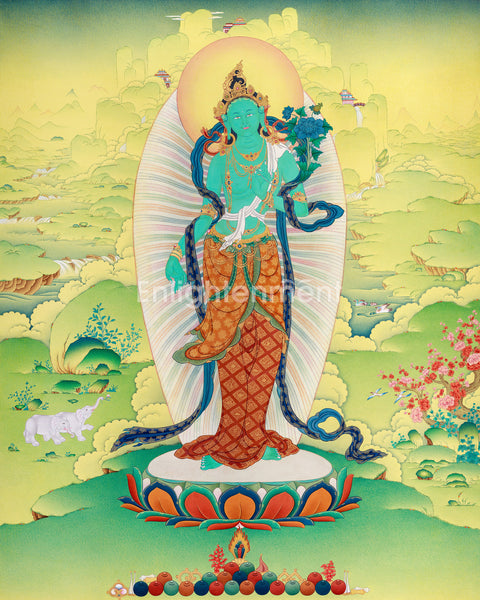
One of Tibetan Buddhism's most revered female goddesses, Tara, is called the "Mother of Liberation." She is sometimes called a savior because of her role in shielding and leading her followers through spiritual and material challenges. She symbolizes the values of accomplishment and success in work.
- Significance and Representation
Tara is known in many colors, each representing a different aspect of her being:
The most well-known type of Tara, Green Tara, represents active compassion and willingness to assist creatures. She is renowned for her ability to rise above even the most trying circumstances and forgiving anyone who contacts her with a prompt, straightforward response.
White Tara, linked to compassion, long life, healing, and tranquility, heals physical and mental wounds.
- What They Are Known For
Tara is especially well-known for gently helping believers face and overcome risks and concerns. She is also called upon for protection when traveling, fertility, and sympathetic care.
Prajnaparamita

In Mahayana Buddhism, the "Perfection of Wisdom," or Prajnaparamita, represents female divinity. She stands for the realization that dispels ignorance and brings about enlightenment. Books and lotuses are frequently depicted in depictions of Prajnaparamita as symbols of knowledge and purity.
- Significance and Representation
Because Prajnaparamita possesses the wisdom that leads to enlightenment, she is regarded as the mother of all Buddhas. Her writings, including the "Diamond Sutra" and the "Heart Sutra," form the basis of Mahayana Buddhism and are vital to comprehending the idea of "emptiness" (Shunyata), which holds that all things are fundamentally devoid of autonomous existence.
- What They Are Known For
In Mahayana Buddhism, the route to enlightenment is based on developing deep insight and realizing the actual nature of reality. Prajnaparamita is respected for her contribution to this process.
Kuan Yin (Guanyin)
The bodhisattva of compassion, Kuan Yin, is sometimes called Avalokiteshvara. She assumed a female form in Chinese Buddhism and is arguably the most adored and honored of the female goddesses in East Asian Buddhism.
- Significance and Representation
Kuan Yin is frequently shown as a young woman wearing flowing white robes. She occasionally has a thousand arms, which represent her capacity to reach out and comfort the suffering people of the globe. She pours forth the waters of compassion from a vase she carries to alleviate pain.
- What They Are Known For
Because of her great compassion, the pious frequently consult Kuan Yin when they are unwell, in need, or experiencing hardship. She is said to be able to hear the cries of all living things and show mercy and compassion to anybody who asks for it. She frequently performs miraculous interventions to keep her followers safe.
Vajrayogini
In the Vajrayana school of Tibetan Buddhism, Vajrayogini is a central figure who symbolizes the essence of ultimate realization. She is shown as a young lady who personifies how ordinary situations may become more spiritually enlightening.
- Significance and Representation
Vajrayogini is frequently shown standing in front of a burning fire, which symbolizes change, with an intense and furious countenance. She is renowned for her ability to see through illusions and teaching the value of overcoming the ego with compassion and intelligence.
Symbolism of Each Deities
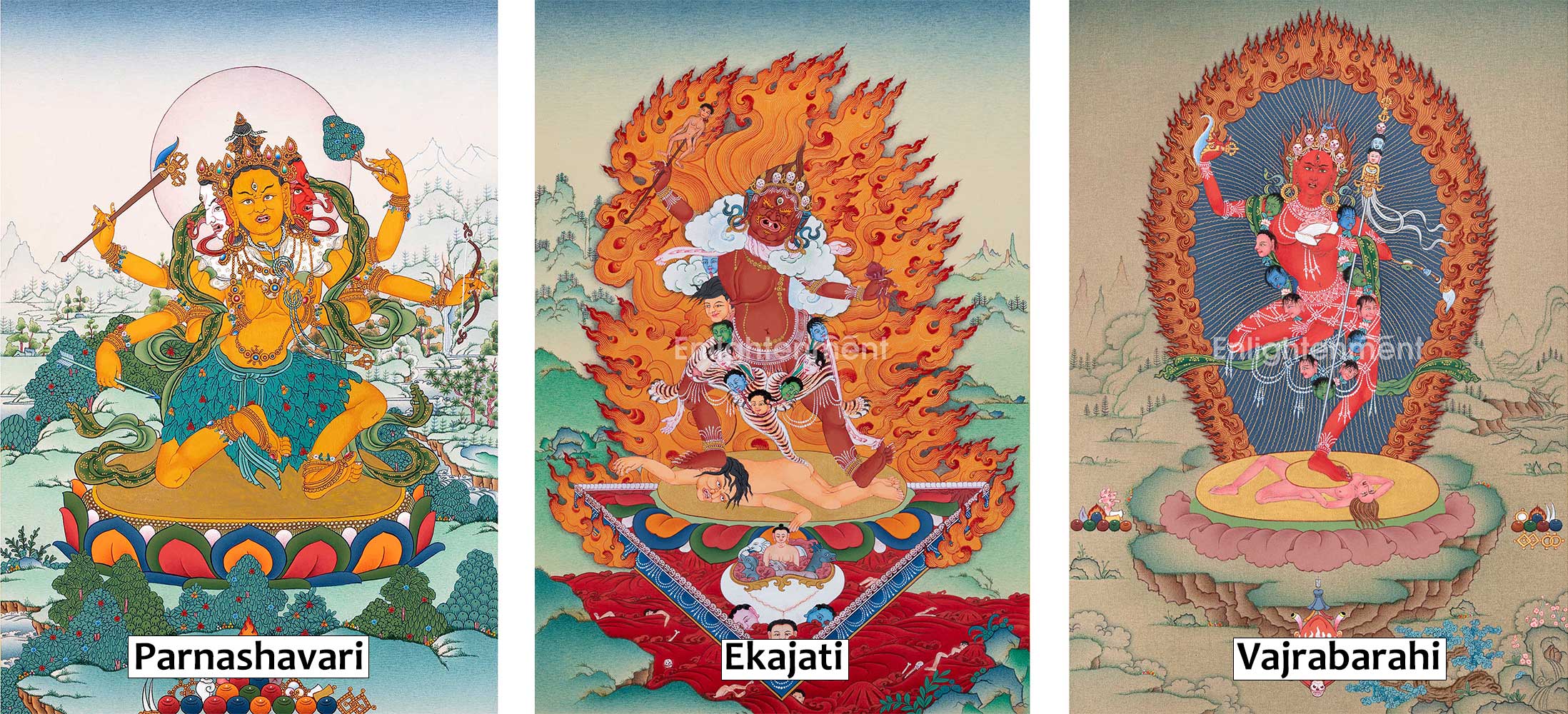
Click here to view our Dakini Thangka Collection
Buddhism's imagery of female goddesses is full of symbolism, with spiritual meaning inherent in every facet of their representation.
These characteristics convey the deities' responsibilities and teachings within Buddhism in addition to helping to identify them. Here is a detailed examination of the appearance and symbolism of a few well-known female deities:
Tara
Tara, particularly in her forms as Green Tara and White Tara, is depicted with a blend of beauty and spiritual depth. Each form has distinct physical attributes:
Green Tara
- Green is a color that represents vitality, energy, and the vibrant aspects of compassion.
- Her right leg is usually thrust forward in a dynamic pose as if she's about to stand up and lend assistance.
- Holds a blue lotus (Utpala), a symbol of strength and purity.
- Expression: Displays a sympathetic yet resolute facial expression, frequently accompanied by a little grin, signifying her willingness to help people in need.
White Tara
- White is a color that represents truth, knowledge, and purity.
- Posture: In an entire lotus posture, representing peace and tranquility.
- She holds a white lotus, which symbolizes spiritual perfection and purity. She is sometimes shown with seven eyes, which represent her omniscient consciousness and include eyes on her hands, feet, and forehead.
- Expression: Her tranquil, calm face conveys her caring personality.
Prajnaparamita
- Prajnaparamita is depicted with features that emphasize her transcendent wisdom.
- Color: Usually bright or golden, signifying the value of her wisdom.
- She usually sits in the lotus posture, symbolizing her steadiness and wisdom-based grounding.
- Symbols: Represents the blossoming of enlightenment; holds a book, usually the Prajnaparamita Sutra, set on a lotus. Occasionally, she is shown with several arms, each of which has a rosary or other object representing the Dharma's ongoing practice.
In Buddhism, female goddesses are extremely important for several reasons. First, they represent the feminine qualities of knowledge, kindness, and action—qualities crucial to practitioners' spiritual growth.
These goddesses—Tara, Prajnaparamita, and Kuan Yin, for example—offer realistic and approachable examples of spiritual achievement for practitioners of all genders.
Second, in Vajrayana Buddhism, feminine goddesses are essential to tantric practice.
Tantra methods frequently use female goddesses as prominent figures, symbolizing the unification of knowledge and compassion in their visualizations, mantras, and rituals. Enlightenment can only be attained by this integration, which is the fusion of dualistic components of reality into a non-dual consciousness.
Balancing the Spiritual and Material Worlds
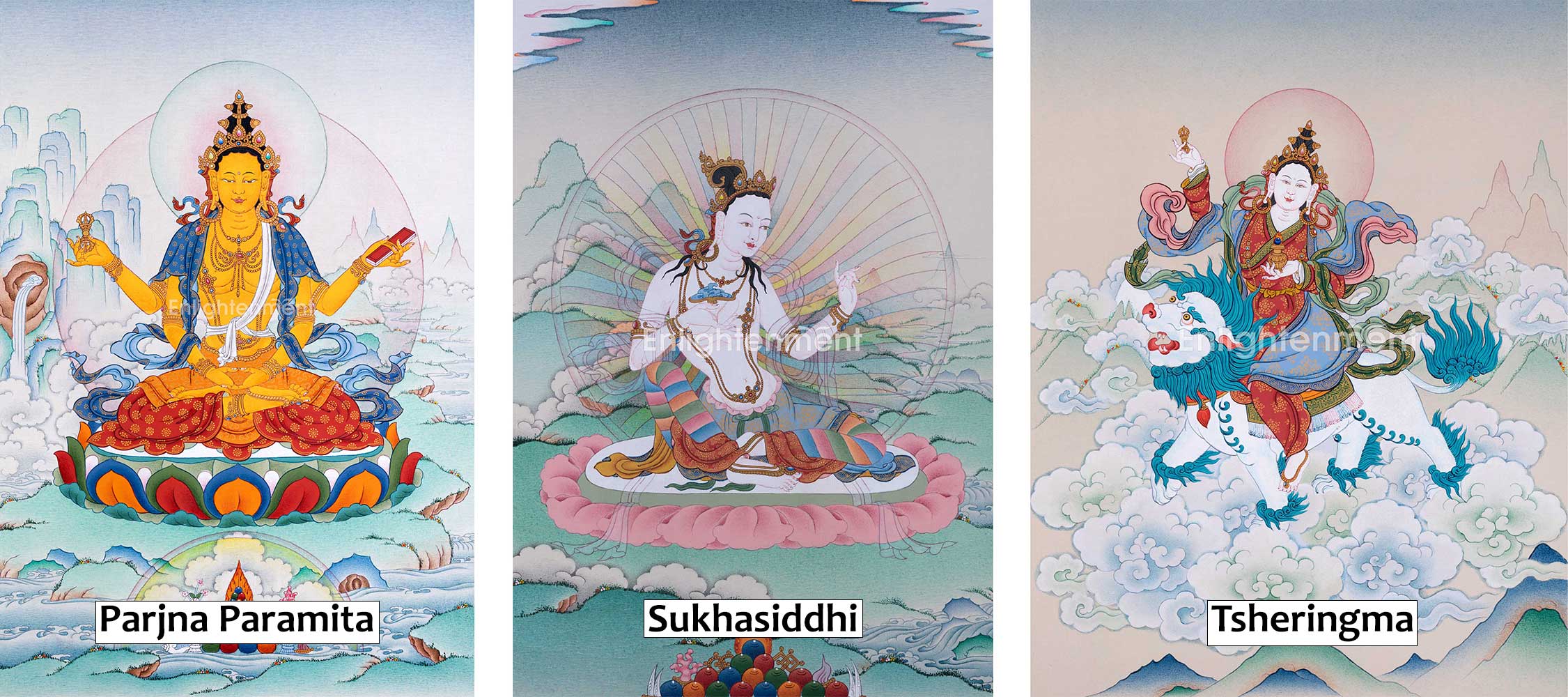
Buddhism's female goddesses emphasize the interconnection of all living forms and the value of a holistic approach to spirituality by counterbalancing the material and spiritual realms.
For example, Green Tara is frequently called upon for her promptness in handling earthly matters, such as guarding against impending harm and supplying needs, and her ability to lead creatures toward spiritual enlightenment.
The representation of deities such as Vajrayogini, who personifies the transcending of earthly passions, also demonstrates this equilibrium.
She teaches that enlightenment does not necessitate the rejection of worldly experiences but rather their transformation into knowledge, using the force of desire to promote spiritual understanding.
Significance in Buddhist Teachings and Practices
Buddhism's ethical and philosophical teachings also emphasize the importance of female deities.
They are the epitome of the Mahayana bodhisattva, who aspires to enlightenment for the benefit of all living things. In this setting, traits like empathy, caring, and emotional intelligence, usually associated with femininity, are praised and given heavenly status.
This emphasizes that these characteristics are just as important for spiritual development as the more highly regarded traits like intelligence and detachment.
Buddhism's devotion to female deities emphasizes the faith's inclusive view of divine attributes and enlightenment.
These deities, representing different facets of spiritual characteristics, are significant to Buddhists worldwide in their religious lives. Their devotion enhances the spiritual practices of many practitioners by reflecting the flexibility and cultural integration of Buddhist doctrine throughout various locations.

